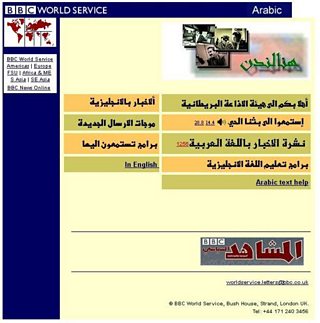Βι¶ΉΤΌΕΔ Arabic at 80: from Radio to Digital
Mustafa Kadhum
Βι¶ΉΤΌΕΔ Arabic Online Editor
Tagged with:

Βι¶ΉΤΌΕΔ Arabic online operation launched in Bush House
Βι¶ΉΤΌΕΔ Arabic is 80 this year, and to mark the occasion Βι¶ΉΤΌΕΔ Arabic Online Editor Mustafa Kadhum charts the development of the network from radio to the digital era.
The chimes of Big Ben and the words “this is London” were the introduction to many in the Middle East to the wider world. At that time (the 1930s), local radio stations were unable to satisfy listeners’ lust for knowledge about what was going on in the world and even in their immediate surroundings.
The radio dial was the main compass, but finding the station one was searching for required great precision in those days. Many were put off because of rising and falling sound levels on the short and medium waves used then, until FM transmission was introduced, which improved reception greatly.
Βι¶ΉΤΌΕΔ Arabic radio took off in the late Thirties, and it quickly gained popularity in the Arab world, thanks to its news, cultural, and entertainment programs, as well as its distinctive presenters.
Back then, radio ruled the media scene due to its great reach. Newspapers were the strict preserve of city elites. Later, television made an entrance, at first locally then through satellite.
At its inception, Βι¶ΉΤΌΕΔ Arabic was not restricted to radio, but also had its own publications such as “The Arabic Listener,” “London calling,” and “The Political Observer.”
At the time Βι¶ΉΤΌΕΔ Arabic was launched, technological progress seemed to be slow. But this soon changed especially with the advent of a new novelty: computers.
At first, computers came in shapes and sizes that would draw a smile from those working with them today. Some of us were fortunate in being able to experience the beginnings of the computer age; others meanwhile chose to wait before delving into the secrets of this new innovation.
Changes began to accelerate at a pace that worried some and raised suspicions in others. Computers in their early iterations literally invaded some workplaces and educational institutions. And it was just a matter of time before their use increased and their capabilities were enhanced. With the advent of the internet and mobile phones, our world took great steps that reduced the concepts of distance and time and in fact almost disposed of them altogether.
A new concept of communication was being created, and novel aspects of the media started to appear. The internet began to reshape ideas and beliefs.
How Did It All Begin?
After the Βι¶ΉΤΌΕΔ embarked on the age of new journalism, Βι¶ΉΤΌΕΔ Arabic decided, in early 1998, to do the same.
A small team of journalists began – in March 1998 – work on an Arabic news site. The project was experimental, as we understood at the time, and its continuance depended on its development and success. It was obvious however that was the way the world was going.
The seed of "new media" that was sown 20 years ago continued to grow and prosper, with many other journalists joining the march of electronic journalism.
We continued to work on the project that we began with meagre resources, a project that eventually bore fruit and proved its viability. The seeds sown in 1998 had grown deep roots.
In the beginning, our work was merely to prepare news items for the rudimentary Βι¶ΉΤΌΕΔ Arabic web page. We used to write stories using a word processor which we then uploaded to the web using FTP. The news was updated on an hourly basis in sync with the radio news bulletins.

Βι¶ΉΤΌΕΔ Arabic front page in 1998
Gradually however, the content of our web news page began to change, with more analyses, specials, press reviews and photo galleries added.
Our team was small at the beginning, but we enjoyed journalistic support from other colleagues in the Arabic Service, as well as technical support from the Βι¶ΉΤΌΕΔ World Service. We used to work individually, and our only contact was through the telephone. The web page was only updated 12 hours a day.
That small team maintained the site for almost a year, before it was reinforced with a number of journalists after the project proved its viability. This was especially the case after the internet began to be seen as a platform that could challenge the hegemony of traditional media outlets.
At that point, the operation began to stabilise, and we embarked on a phase of journalistic and technical innovation. As part of the Βι¶ΉΤΌΕΔ, we were able to make use of the vastly more experienced Βι¶ΉΤΌΕΔ News website for editorial and technical training.
With the advent of the new century, the Βι¶ΉΤΌΕΔ Arabic website witnessed a quantum leap that included great improvements in content, shape, and size – until it reached its present form. The site takes into account visitors’ preferences, and is updated 24 hours a day, seven days a week.
The Arabic website, in addition to being a rich source of news, became a conveyor of Βι¶ΉΤΌΕΔ content in its various forms including both radio and television, especially after the Βι¶ΉΤΌΕΔ pioneered the adoption of multimedia operation.
Βι¶ΉΤΌΕΔ Arabic content is now more varied and available on pages, our partners’ sites and via internet search engines, as well as on social media.
The Βι¶ΉΤΌΕΔ Arabic website has undergone continuous changes, thanks to the advances made in internet technology. These changes and advances will not stop, but will continue into the future in line with information technology that never looks back.
Mustafa Kadhum is Βι¶ΉΤΌΕΔ Arabic Online Editor
- Visit
- and
